 As a piano teacher, you have probably been in the situation where you felt that using your favorite traditional piano method might not be the best choice for a particular new student’s situation.
As a piano teacher, you have probably been in the situation where you felt that using your favorite traditional piano method might not be the best choice for a particular new student’s situation.
For example, perhaps you have a new student who already has experience reading music from school or band. Or an older beginner with a great ear who is largely self-taught. Or an adult student who is returning to piano lessons after a number of years. Or perhaps you have an average-age beginner who isn’t thriving in their method books and would benefit from additional supplement.
For those special situations, it is useful to be familiar with some method book alternatives, which I fondly refer to as “un-methods.” Un-methods are useful for creating structure in weekly piano assignments while maintaining the flexibility to round out the student’s curriculum with other styles of music they are interested in. In my mind, an un-method must meet at least two out of these three criteria:
- Uses on-staff note reading.
- Little to no illustrations or text on the page.
- All-in-one book, for the most part.
Below is my list of some un-methods that you might enjoy exploring!
Right From The Start, by Lynn Freeman Olson (Fischer)
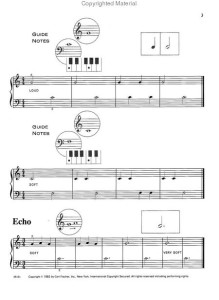
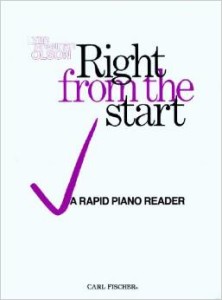 As the cover states, this thin volume is a “rapid piano reader.” Teachers who appreciate a landmark (aka interval) reading approach will appreciate the way this on-staff book begins: by teaching Bass F, Middle C, and Treble G. The book provides a solid, no-nonsense approach. I think it is a great book that truly leaves the teaching up to the teacher!
As the cover states, this thin volume is a “rapid piano reader.” Teachers who appreciate a landmark (aka interval) reading approach will appreciate the way this on-staff book begins: by teaching Bass F, Middle C, and Treble G. The book provides a solid, no-nonsense approach. I think it is a great book that truly leaves the teaching up to the teacher!
By the end of this 30-page book, students are playing basic rhythms (no eighth notes, unfortunately) within quarter note meters (3/4 and 4/4 time), a variety of articulations (staccato, legato) and notes covering the entire grand staff.
View it on Amazon or SheetMusicPlus.com.
Beginning Piano Repertoire, by Keith Snell
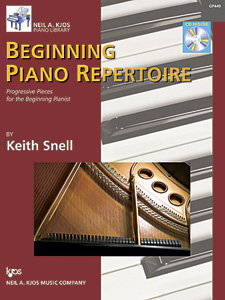 This book begins with on-staff reading using a Middle C approach. The examples are short (mostly one or two lines in length) and to-the-point, with no lyrics or illustrations. The first few pieces require students to play with their thumbs sharing Middle C (which is not only uncomfortable, but it can be dangerous because students might wrongly learn to associate certain piano keys with certain fingers), but fortunately after page 9, the pieces begin to require various hand positions. There is an accompanying CD with duet parts, which may appeal to some students.
This book begins with on-staff reading using a Middle C approach. The examples are short (mostly one or two lines in length) and to-the-point, with no lyrics or illustrations. The first few pieces require students to play with their thumbs sharing Middle C (which is not only uncomfortable, but it can be dangerous because students might wrongly learn to associate certain piano keys with certain fingers), but fortunately after page 9, the pieces begin to require various hand positions. There is an accompanying CD with duet parts, which may appeal to some students.
By the end of this 23-page book, students are playing key signatures of one sharp or one flat, intervals up to 6ths, legato and staccato, 3/4 and 4/4 time, and eighth note rhythms.
View it on SheetMusicPlus.com. There is an accompanying Theory Book and Technic Book to use, if desired. Of course, using all of those books would make it less un-method-y… 🙂
The Joy of First-Year Piano, by Denes Agay
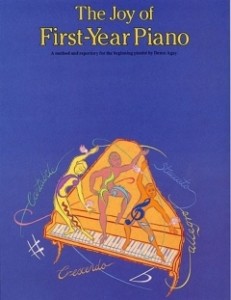 This book begins with some useful pages about basic piano posture and note-reading. There are also a few pages of rote pieces the teacher may choose to teach the student before proceeding to on-staff reading. A Middle C approach is used to introduce reading on the staff. A hand position with the thumbs sharing C is required until page 22. The pieces are interesting and rich, including familiar folk tunes, classical themes, and original pieces by Denes Agay. Some of the pieces include teacher duets, which is a nice bonus.
This book begins with some useful pages about basic piano posture and note-reading. There are also a few pages of rote pieces the teacher may choose to teach the student before proceeding to on-staff reading. A Middle C approach is used to introduce reading on the staff. A hand position with the thumbs sharing C is required until page 22. The pieces are interesting and rich, including familiar folk tunes, classical themes, and original pieces by Denes Agay. Some of the pieces include teacher duets, which is a nice bonus.
By the end of this 80-page book, students will be playing pieces in 3/4, 4/4, or 6/8 time (as well as a random piece in 5/4), key signatures up to one flat or two sharps, rhythm values including dotted-eighth-sixteenths and triplets, and various articulations.
View it on Amazon or SheetMusicPlus.com.
Pathways to Artistry, by Catherine Rollin
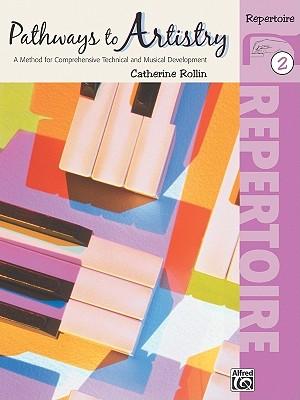 Pathways to Artistry is not designed to be a series for complete beginners; rather, it is intended to bridge the gap between early levels of method books and intermediate masterwork repertoire. The series consists of a Technique Book, a Repertoire Book, and a Masterworks Book at levels 1-3, although each book can certainly be used independently (or try using 2 out of the 3). The Repertoire Books contains newly composed music by Catherine Rollin, while the Masterworks and Technique Books contain easy piano etudes and short classical pieces.
Pathways to Artistry is not designed to be a series for complete beginners; rather, it is intended to bridge the gap between early levels of method books and intermediate masterwork repertoire. The series consists of a Technique Book, a Repertoire Book, and a Masterworks Book at levels 1-3, although each book can certainly be used independently (or try using 2 out of the 3). The Repertoire Books contains newly composed music by Catherine Rollin, while the Masterworks and Technique Books contain easy piano etudes and short classical pieces.
The pieces are mostly five-finger pieces. The pieces are accompanied by text to indicate the historical time period and to remind students of various physical movements they should be using at certain points during the pieces. These books might also be a good solution for transfer students, or adult students who have had some previous study.
Check out the Repertoire Book 1 on Amazon or SheetMusicPlus, the Technique Book 1 on Amazon or SheetMusicPlus, or the Masterworks Book 1 on Amazon or SheetMusicPlus.
Configurations, by Jon George
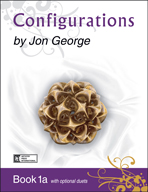 The 64 elementary-level pieces in this book are wonderfully varied, embracing a variety of styles, idioms, moods, and meters (I’m always excited to find compound meters at elementary levels!). Jon George’s writing here is rich and interesting as always (see my more complete review of his music here). Each piece comes with a “study page” designed to help students learn to recognize patterns and motives in music, which can assist their music memorization skills. Teacher duets are provided.
The 64 elementary-level pieces in this book are wonderfully varied, embracing a variety of styles, idioms, moods, and meters (I’m always excited to find compound meters at elementary levels!). Jon George’s writing here is rich and interesting as always (see my more complete review of his music here). Each piece comes with a “study page” designed to help students learn to recognize patterns and motives in music, which can assist their music memorization skills. Teacher duets are provided.
View it at ArtistryAlliance.com.
Also see the “Patterns for Piano,” which is similar in its approach but progresses more rapidly to an intermediate level. (No study pages or teacher duets, though). It’s great for adult students.
Perfect Start for Piano, by Kevin & Julia Olson
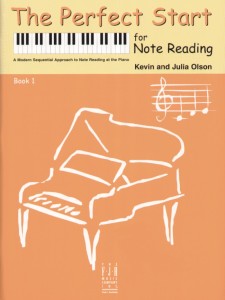 This series can serve as a nice supplement to any piano method, particularly for any young students who need a supplement for note-reading or who require a slow progression with a great deal of repetition and reinforcement. The reading approach is a very slow-moving, Middle C approach. Notes are taught one-at-a-time and there are many simple pieces to go with each new concept. There are simple, clip-art style illustrations. Teacher duets are included on the pages. The accompanying website, ThePerfectStartForPiano.com, contains many free printables.
This series can serve as a nice supplement to any piano method, particularly for any young students who need a supplement for note-reading or who require a slow progression with a great deal of repetition and reinforcement. The reading approach is a very slow-moving, Middle C approach. Notes are taught one-at-a-time and there are many simple pieces to go with each new concept. There are simple, clip-art style illustrations. Teacher duets are included on the pages. The accompanying website, ThePerfectStartForPiano.com, contains many free printables.
Books 1, 2, and 3 available. Exercise books and Solos books also available.
View it on SheetMusicPlus.com.
Piano Pronto, by Jennifer Eklund
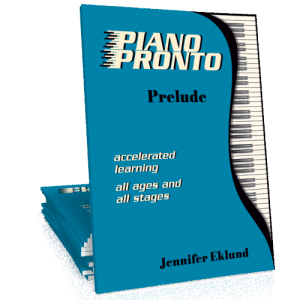 Although Piano Pronto is definitely intended to be a piano method instead of an “un-method,” I decided to mention it here because it actually does contain all three of my criteria for an un-method; namely, minimal use of illustrations/text, on-staff reading from the beginning, and an all-in-one book approach.
Although Piano Pronto is definitely intended to be a piano method instead of an “un-method,” I decided to mention it here because it actually does contain all three of my criteria for an un-method; namely, minimal use of illustrations/text, on-staff reading from the beginning, and an all-in-one book approach.
Piano Pronto uses a unique reading approach. It is similar to a Middle C approach in that it begins with on-staff reading and the first few notes introduced are Middle C through Treble G, but the next notes introduced are Bass C through Bass G instead of Bass F through Middle C. I guess you could call it a “C Position” reading approach. 🙂 The advantage of this approach is that the hands are never required to play with the thumbs sharing Middle C. Piano Pronto also requires students to move their hands frequently during a piece. It is refreshing to see students who do not find position shifts daunting!
By the end of this 73-page book, students are playing pieces covering practically the entire grand staff, ledger lines, accidentals, intervals up to a 6th, and eighth note rhythms within quarter note meters.
View it at PianoPronto.com. Also available: Keyboard Kick-Off, which uses a slower approach that may be more appropriate for younger beginners.
Teaching Little Fingers to Play, by John Thompson
 Perhaps I’m somewhat biased because I have such fond memories of learning these pieces when I was a beginner, but I think John Thompson’s music is timeless and beautiful. Yes, this method uses a Middle C approach with the thumbs sharing C until halfway through the book. Fortunately, the pace is pretty rapid in this book (assuming the student is learning each new piece in a one or two week’s time), preventing the student from learning to associate certain fingers with certain piano keys. Don’t use this with young beginners unless they are very precocious!
Perhaps I’m somewhat biased because I have such fond memories of learning these pieces when I was a beginner, but I think John Thompson’s music is timeless and beautiful. Yes, this method uses a Middle C approach with the thumbs sharing C until halfway through the book. Fortunately, the pace is pretty rapid in this book (assuming the student is learning each new piece in a one or two week’s time), preventing the student from learning to associate certain fingers with certain piano keys. Don’t use this with young beginners unless they are very precocious!
Fun fact: Have you ever noticed that on the cover of this book, John Thompson indicated that his pieces were intended to be taught combining rote teaching and note teaching? I think this piece of information is very important for understanding his book!
A downside of this book is that there are more finger numbers indications throughout than necessary. I wish Willis Music Company would consider removing some of the fingerings in the new printings. I scribble out or white-out the superfluous fingerings. (While they are at it, maybe they could return to the original line-drawing illustrations, which were wonderful!)
Today, I use the “Teaching Little Fingers to Play” book once-in-a-while as a supplement alongside a more current method, especially when I want to slow down the student’s progress so they have more time to absorb each concept as the music becomes more difficult. I’ve also used it as the core method book when I want to jump-start an older beginner with on-staff reading. Instead of following up with the 1st Grade Book, I move the student into the Faber “Piano Adventures” Level 1, which happens to be a perfect transition.
Another fun fact: The “Teaching Little Fingers to Play More” book that follows this book was actually not written by John Thompson. It was written by Leigh Kaplan in 2005 with the intent of creating a smoother transition into the rigorous “John Thompson’s Modern Course for Piano: 1st Grade Book.”
View it at Amazon or SheetMusicPlus.
Pageants for Piano 1A, by Donald Waxman
![]()
![]()
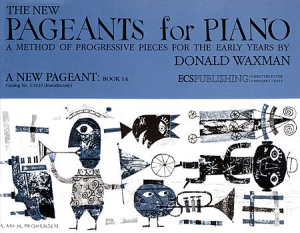
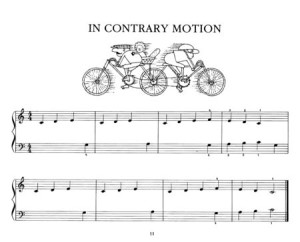
Donald Waxman is a composer of various instrumental music who also wrote a piano method filled with wonderfully unique, avant-garde-sounding music. This book does contain illustrations, but they are charming and interesting rather than childish. The reading approach used is the Middle C approach. A hand position with the thumbs sharing Middle C is required until page 18. Eighth notes and accidentals are taught early on.
By the end of this 35-page book, students are playing basic quarter note time signatures, basic rhythms including eighth notes, and a range of notes from Bass C through Treble C.
If you want to order this book, look for the newer “1A” book rather than using the older “1” book. The accompanying Theory Books are unique because they teach composition. Personally, I wouldn’t recommend going on to Book 2 after completing 1A, but I think the 1A book is an interesting option as an introductory book for staff reading or as a supplement to another method. The dissonance and unusual harmonies will introduce up a new world of sounds for the students’ ears.
View it on Amazon or SheetMusicPlus.com.
Have a suggestion for another un-method for my list? Leave a comment below!
You may be interested in: 9 First Classical Anthologies for Piano Students



thank you so much for spending time for this research. It is beneficial for all of us.
Your reviews are so helpful! I’m glad to know I’m not the only one who’s a little frustrated by the prevalence of thumbs sharing middle c position.
My first favorite un-method book for young students is Accent on Solos, Level 1, by Wiliam Gillock ( Willis Music Co.,HL00416295). My second favorite is Noona Clavier, Repertoire 1. (Walter & Carol Noona, Heritage Music Press, KM143). Although it is from a series I only use this book. Both books include early elementary and mid-elementary music. The pieces are varied in style and the titles of the pieces open the door for a musical conversation…..”Drifting”, “Toccatina” “Wind in the Bamboo Tree”, “Daddy’s Rocking Chair”. These books are a great place to start when you are looking for pieces to build a “musical” 10 piece piano guild program for an elementary level student.
Ty Joy for a wonderful article !! And Ty Marcia for great list…
I’ll have to check those out, Marcia! Thanks for the recommendations!
Great list, there’s several on here I’m interested in looking into! Have you ever looked at Debra Perez’s Way Cool Keyboarding and Way Cool Keyboarding for kids bookstore? I think these fit perfectly into the “un-method” category and I’ve had a lot of success using these with non-traditional piano students. The accompaniment cd is especially appealing to older beginners.
I haven’t tried those books, Spring, but I have heard good things about them! I’ll have to check them out sometime!
Another helpful article…thank you Joy, there is much of interest here.
You’re welcome, Margaret!
Good list, thanks for share it. I had read only the Donald Waxman,s book, and i really enjoyed it.
Great post. I’ve been looking for similar books over the last few years as well. I have used the Way Cool Keyboarding on occasion. Right now I have a senior in HS who has only been playing 3 years and is just playing for fun at this point. The WCK sounds cool and they’re great pattern pieces. I’ve also used Right from the Start – Lynn Freeman Olson also has a book called “Beginnings” which is great for reading patterns from high and low C. I’ve used Christopher Goldston’s Intervallic Reading Series’s “On Stage!” and “Be a Star!” for teaching interval and pattern reading to beginning HS students who can already read music from band but have never played piano. “Patterns for Fun” by Paul Sheftel and Vera Wills is great. They give a “preparation/building blocks” page prior to every piece. I know that’s a lot of books to share, but I just had to add them to your list!
Wow!! Thank you, thank you! I have had 3 adults ask me about taking lessons recently which is a totally new field for me. This info is invaluable!!
I have had GREAT success with Pathways to Artistry. Especially when the jump from level 2B to 3 is too big for my students. Granted I didn’t have teachers who really taught technique, but I myself have taught myself better and more healthy playing technique by going through them. I also use them along side my preferred method in a lot of cases. I use just Technique and Masterworks (kids live playing “real” music by “real” composers, I’ve found). I start level 1 technique with level 2A method books, and add the Masterworks with 2B so they’ve had a chance to learn all the techniques before applying them to repertioire. I have a music ed degree with my main instrument being flute. It seems that all the wonderful musicianship advice and accepted rules for playing musically are written out in Rollins’ books. I’ve been in contact with her via email about her providing video resources to send links to parents so they can have a visual reference of what everything is supposed to look like during the practice week. She is interested in providing this, just trying to find a way to make it cost effective by password protecting the content in order to charge some sort of access fee to recover the cost of producing such material.
I learned with the John Thompson series, and I think I was Teaching Little Fingers to Play, but I had NO IDEA there was to be a from rote component!
Melissa, thanks so much for sharing your experience with the Pathways to Artistry books! And that would be so exciting if Catherine Rollin decided to launch some kind of online support for the books. Awesome!
Thanks you for this article, I am a new piano teacher and I am looking to build my supplemental material options. This was so helpful! 🙂
Hi Joy, I’ve started incorporating ‘Playing the Piano: For a Little Pianist’ by Boris Milich into my lessons recently. The looks on the children’s faces when they see this book say it all. You wanted un-methods? Just show them the first page (there are 3 examples)! I challenge any teacher who tries this method (just a few examples should suffice) to name another book whose content produces the same look of challenge/concentration on their students faces 🙂 Their comments afterwards are similarly unforgettable.
Text is in Russian – but, alas! The staff and finger numbers suffice to send students on a musical journey they’ll never forget!
https://ruslania.com/sheetmusic/152730/playing-the-piano-for-a-little-pianist-ed-by-milich-boris